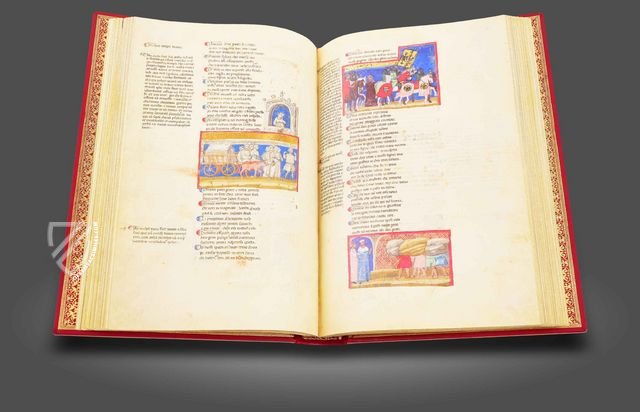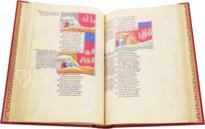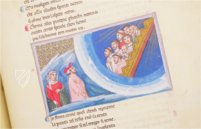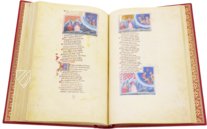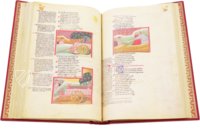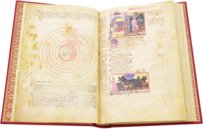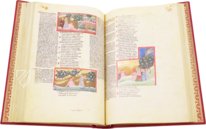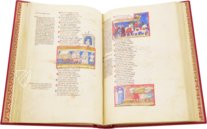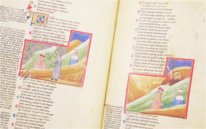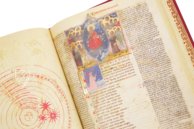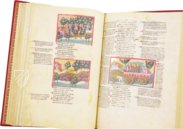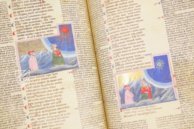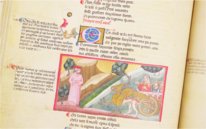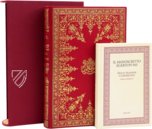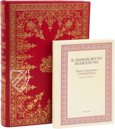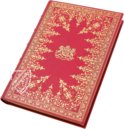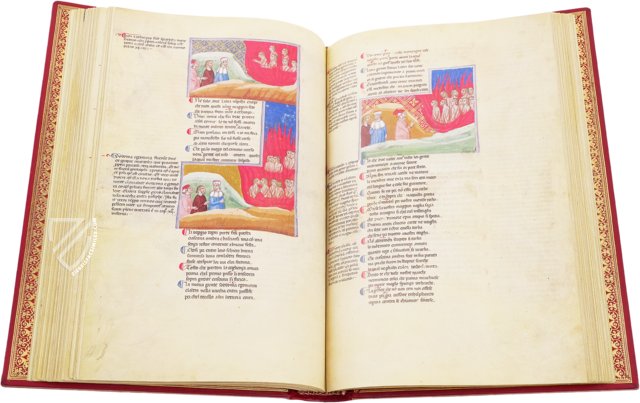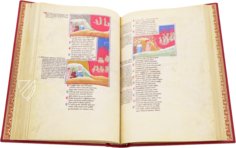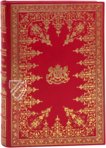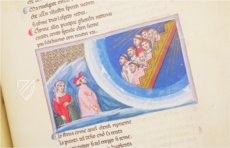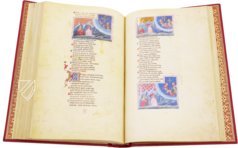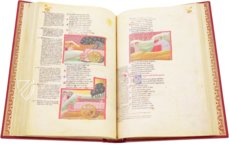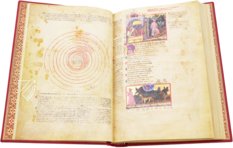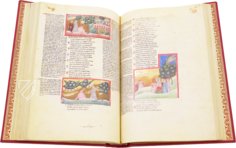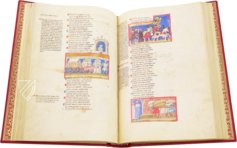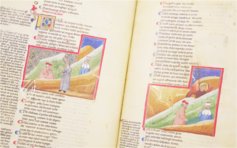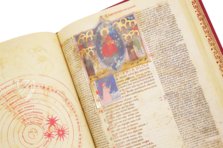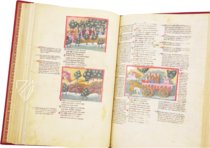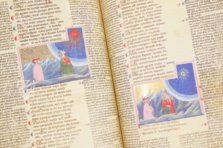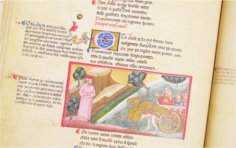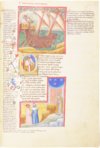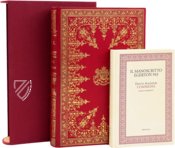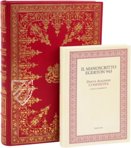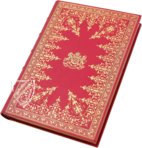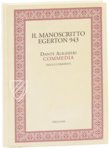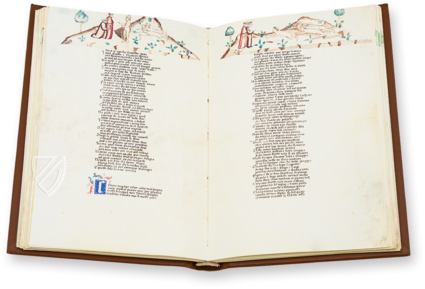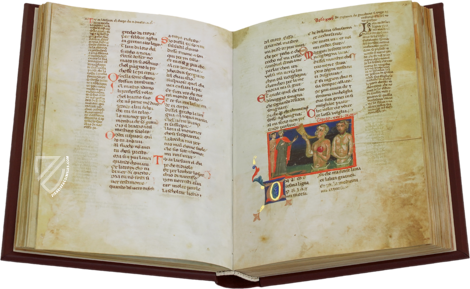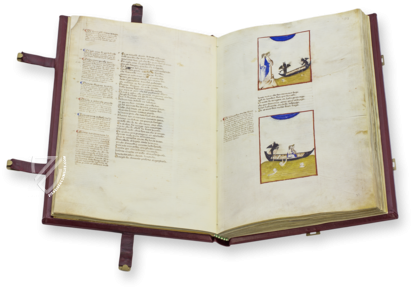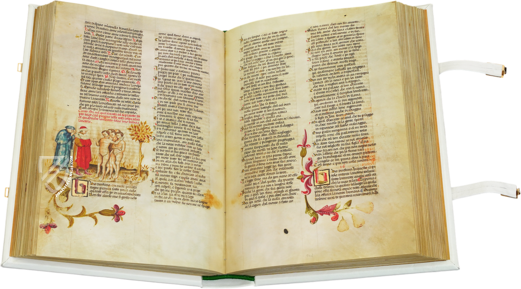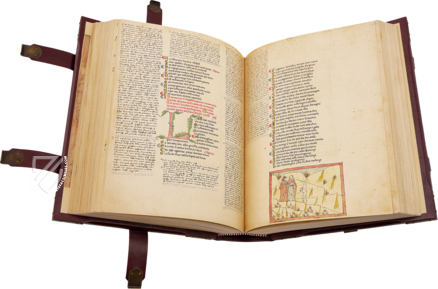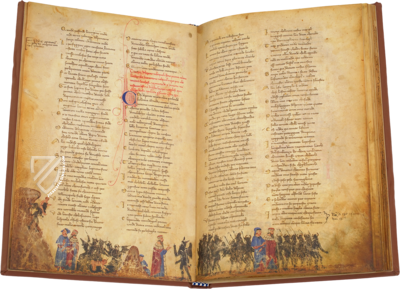Divine Comedy Egerton 943
(1,000€ - 3,000€)
One of the oldest and most beautiful specimens of the Divine Comedy by Dante Alighieri (ca. 1265–1321) was created in Padua in the early–14th century. The work was formational for the modern Italian language, and Dante stands as one of the most important authors of the entire Middle Ages. Although the patron of this particular manuscript remains anonymous, it is believed to originate from Padua from the workshop of the Master of the Antiphonary of Padua. The 253 miniatures and other décor in the manuscript demonstrate influences from the Italian Trecento and specifically from the Bolognese school. It displays innovative features such as early attempts at three-dimensionality, and stands out among the illuminated manuscripts of Dante’s magnum opus.
Divine Comedy Egerton 943
Dante Alighieri (ca. 1265–1321) is considered to be the father of the Italian language and his Divina Commedia is not only considered to be the preeminent work of Italian literature but also the most important poem of the Middle Ages. In it, he travels through Hell, Purgatory, and Paradise as he is guided by the Roman poet Virgil (70–21 BC). During his allegorical journey, he comes into contact with many prominent historical figures. The work has since influenced countless of other authors and is one of the most referenced pieces of literature in the Western literary tradition.
An Early Dante Masterpiece
The early–14th century specimen from Padua that we have before us today is one of the oldest and most beautiful editions of Dante’s work, and in fact predates the application of the term “Divine” to the title, which first appeared in 1555. It features 253 miniatures in red frames in addition to historiated initials and diagrams of heaven, hell, and Earth. The lovely colors of the illustrations are further elevated through the use of shimmering gold and silver. This artistic program has been ascribed to the Master of the Antiphonary of Padua and is supposed to directly aid the reader in comprehending the text, part of a tradition that has come to be known as “Dante Illustrato”. No patron has ever been determined. Every page features either 16 tercets (three lined poems) or 12–13 tercets with a miniature. The influence of the Trecento and the Bolognese school in particular are evident in the decorative grounds and the tendency of the figures to exceed their frames. Figure are often facing away from the reader, giving the impression that the miniature is only a window into a larger scene. The miniatures possess a nascent three-dimensionality, adding to the narrative realism of the manuscript. All of this is housed in a 17th century binding of red leather with gold tooling.
Codicology
- Alternative Titles
- Dante Alighieri - Göttliche Komödie - Egerton 943
La Divina Commedia - Il codice Egerton
Divine Comedy - Egerton Manuscript - Size / Format
- 376 pages / 39.0 × 26.0 cm
- Origin
- Italy
- Date
- 1320–1350
- Epochs
- Style
- Genre
- Script
- Gothic Textura Rotunda
- Illustrations
- 261 gold- and silver-adorned miniatures in red frames; 3 historiated initials; 2 diagrams depicting Hell; floral foliate initials throughout
- Content
- Text of the Divine Comedy with Latin commentaries and the verses added by Jacopo Alighieri
- Artist / School
- Master of the Antiphonar of Padua
- Previous Owners
- Baron August von Koller
Divine Comedy Egerton 943
Dominic, Thomas Aquinas, and Francis
In the Fourth Sphere of Heaven, the Sun, which is the realm of the Wise, Dante and Beatrice encounter examples of souls who have illuminated the world intellectually. Here they encounter three of the most important figures of the medieval church: St. Dominic, the founder of the order to which the great theologian Thomas Aquinas belonged, and St. Francis of Assisi, founder of the Franciscan Order, who is humbly dressed in brown. Although the two orders were not always friendly on earth, in Paradise they praise one another in the spirit of love.
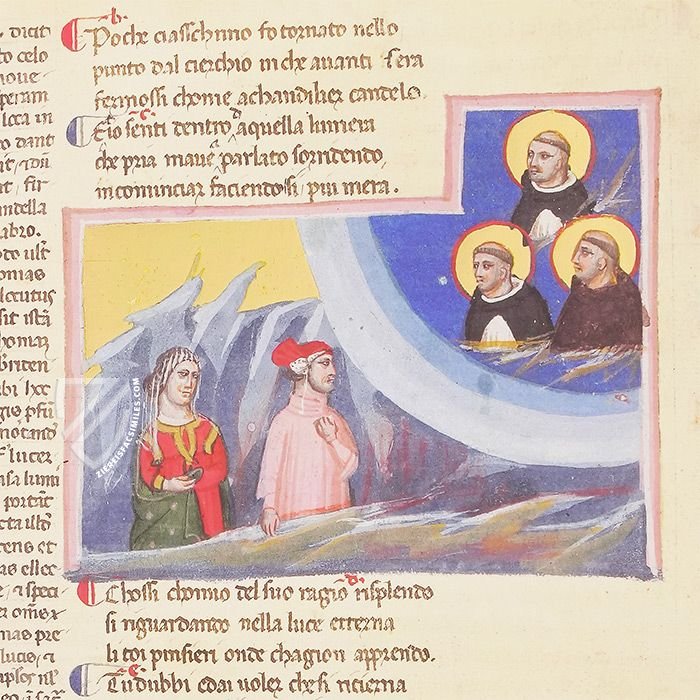
Divine Comedy Egerton 943
Trajan and the Widow / The Proud Carrying Heavy Stones
Medieval Christian theologians regarded the Roman Emperor Trajan, who reigned from AD 98 to 117, to be a virtuous pagan and an example of justice, majesty, humility, and chivalry who, according to legend, once stopped his grand entourage in order to render justice to a poor widow, which is depicted here. Trajan is crowned and dressed in red while the widow stands before him dressed in black with her hand stretched out before her pleading for help.
The lower miniature shows an opposite example: those guilty of Pride, who are overburdened with heavy stones that cause them to be bent over at the waste. They are stripped of all their finery, are barefoot, and wear only simple tunics, while the well-dressed Dante and Virgil look on from the left. The red background is embellished with an elaborate diamond pattern featuring flowers and Greek crosses with trefoil end caps.
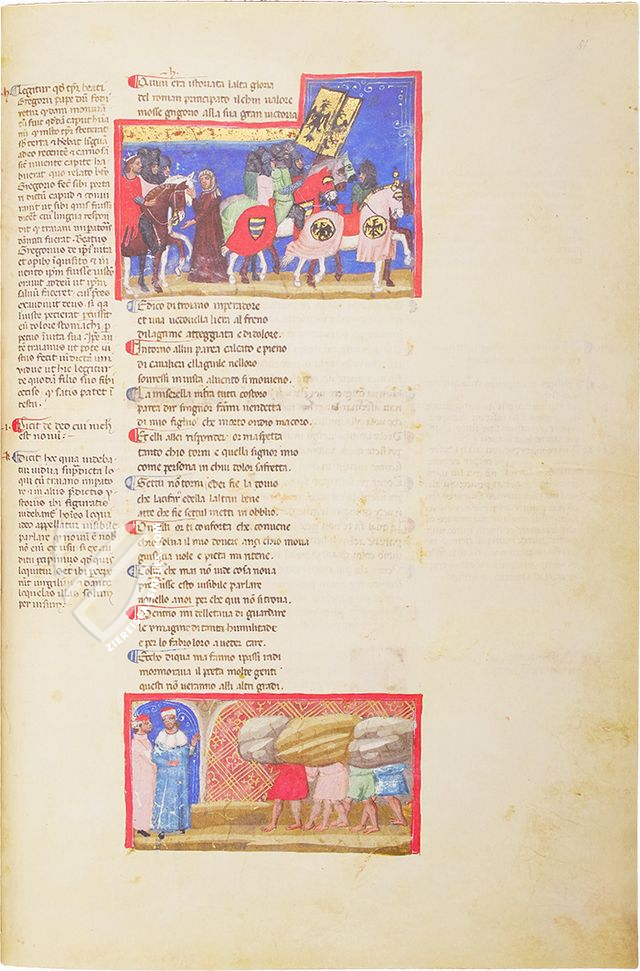
#1 La Divina Commedia - Il codice Egerton
Language: Italian
(1,000€ - 3,000€)
- Treatises / Secular Books
- Apocalypses / Beatus
- Astronomy / Astrology
- Bestiaries
- Bibles / Gospels
- Chronicles / History / Law
- Geography / Maps
- Saints' Lives
- Islam / Oriental
- Judaism / Hebrew
- Single Leaf Collections
- Leonardo da Vinci
- Literature / Poetry
- Liturgical Manuscripts
- Medicine / Botany / Alchemy
- Music
- Mythology / Prophecies
- Psalters
- Other Religious Books
- Games / Hunting
- Private Devotion Books
- Other Genres
- Afghanistan
- Armenia
- Austria
- Belgium
- Belize
- Bosnia and Herzegovina
- China
- Colombia
- Costa Rica
- Croatia
- Cyprus
- Czech Republic
- Denmark
- Egypt
- El Salvador
- Ethiopia
- France
- Germany
- Greece
- Guatemala
- Honduras
- Hungary
- India
- Iran
- Iraq
- Israel
- Italy
- Japan
- Jordan
- Kazakhstan
- Kyrgyzstan
- Lebanon
- Liechtenstein
- Luxembourg
- Mexico
- Morocco
- Netherlands
- Palestine
- Panama
- Peru
- Poland
- Portugal
- Romania
- Russia
- Serbia
- Spain
- Sri Lanka
- Sweden
- Switzerland
- Syria
- Tajikistan
- Turkey
- Turkmenistan
- Ukraine
- United Kingdom
- United States
- Uzbekistan
- Vatican City
- A. Oosthoek, van Holkema & Warendorf
- Aboca Museum
- Ajuntament de Valencia
- Akademie Verlag
- Akademische Druck- u. Verlagsanstalt (ADEVA)
- Aldo Ausilio Editore - Bottega d’Erasmo
- Alecto Historical Editions
- Alkuin Verlag
- Almqvist & Wiksell
- Amilcare Pizzi
- Andreas & Andreas Verlagsbuchhandlung
- Archa 90
- Archiv Verlag
- Archivi Edizioni
- Arnold Verlag
- ARS
- Ars Magna
- ArtCodex
- AyN Ediciones
- Azimuth Editions
- Badenia Verlag
- Bärenreiter-Verlag
- Belser Verlag
- Belser Verlag / WK Wertkontor
- Benziger Verlag
- Bernardinum Wydawnictwo
- BiblioGemma
- Biblioteca Apostolica Vaticana (Vaticanstadt, Vaticanstadt)
- Bibliotheca Palatina Faksimile Verlag
- Bibliotheca Rara
- Boydell & Brewer
- Bramante Edizioni
- Bredius Genootschap
- Brepols Publishers
- British Library
- C. Weckesser
- Caixa Catalunya
- Canesi
- CAPSA, Ars Scriptoria
- Caratzas Brothers, Publishers
- Carus Verlag
- Casamassima Libri
- Centrum Cartographie Verlag GmbH
- Chavane Verlag
- Christian Brandstätter Verlag
- Circulo Cientifico
- Club Bibliófilo Versol
- Club du Livre
- CM Editores
- Collegium Graphicum
- Collezione Apocrifa Da Vinci
- Comissão Nacional para as Comemorações dos Descobrimentos Portugueses
- Coron Verlag
- Corvina
- CTHS
- D. S. Brewer
- Damon
- De Agostini/UTET
- De Nederlandsche Boekhandel
- De Schutter
- Deuschle & Stemmle
- Deutscher Verlag für Kunstwissenschaft
- DIAMM
- Droz
- E. Schreiber Graphische Kunstanstalten
- Ediciones Boreal
- Ediciones Grial
- Ediclube
- Edições Inapa
- Edilan
- Editalia
- Edition Deuschle
- Edition Georg Popp
- Edition Leipzig
- Edition Libri Illustri
- Editiones Reales Sitios S. L.
- Éditions de l'Oiseau Lyre
- Editions Medicina Rara
- Editorial Casariego
- Editorial Mintzoa
- Editrice Antenore
- Editrice Velar
- Edizioni Edison
- Egeria, S.L.
- Eikon Editores
- Electa
- Emery Walker Limited
- Enciclopèdia Catalana
- Eos-Verlag
- Ephesus Publishing
- Ernst Battenberg
- Eugrammia Press
- Extraordinary Editions
- Fackelverlag
- Facsimila Art & Edition
- Facsimile Editions Ltd.
- Facsimilia Art & Edition Ebert KG
- Faksimile Verlag
- Feuermann Verlag
- Folger Shakespeare Library
- Franco Cosimo Panini Editore
- Friedrich Wittig Verlag
- Fundación Hullera Vasco-Leonesa
- G. Braziller
- Gabriele Mazzotta Editore
- Gebr. Mann Verlag
- Gesellschaft für graphische Industrie
- Getty Research Institute
- Giovanni Domenico de Rossi
- Giunti Editore
- Graffiti
- Grafica European Center of Fine Arts
- Guido Pressler
- Guillermo Blazquez
- Gustav Kiepenheuer
- H. N. Abrams
- Harrassowitz
- Harvard University Press
- Helikon
- Hendrickson Publishers
- Henning Oppermann
- Herder Verlag
- Hes & De Graaf Publishers
- Hoepli
- Holbein-Verlag
- Houghton Library
- Hugo Schmidt Verlag
- Idion Verlag
- Il Bulino, edizioni d'arte
- ILte
- Imago
- Insel Verlag
- Insel-Verlag Anton Kippenberger
- Instituto de Estudios Altoaragoneses
- Instituto Nacional de Antropología e Historia
- Introligatornia Budnik Jerzy
- Istituto dell'Enciclopedia Italiana - Treccani
- Istituto Ellenico di Studi Bizantini e Postbizantini
- Istituto Geografico De Agostini
- Istituto Poligrafico e Zecca dello Stato
- Italarte Art Establishments
- Jan Thorbecke Verlag
- Johnson Reprint Corporation
- Josef Stocker
- Josef Stocker-Schmid
- Jugoslavija
- Karl W. Hiersemann
- Kasper Straube
- Kaydeda Ediciones
- Kindler Verlag / Coron Verlag
- Kodansha International Ltd.
- Konrad Kölbl Verlag
- Kurt Wolff Verlag
- La Liberia dello Stato
- La Linea Editrice
- La Meta Editore
- Lambert Schneider
- Landeskreditbank Baden-Württemberg
- Leo S. Olschki
- Les Incunables
- Liber Artis
- Library of Congress
- Libreria Musicale Italiana
- Lichtdruck
- Lito Immagine Editore
- Lumen Artis
- Lund Humphries
- M. Moleiro Editor
- Maison des Sciences de l'homme et de la société de Poitiers
- Manuscriptum
- Martinus Nijhoff
- Maruzen-Yushodo Co. Ltd.
- MASA
- Massada Publishers
- McGraw-Hill
- Metropolitan Museum of Art
- Militos
- Millennium Liber
- Müller & Schindler
- Nahar - Stavit
- Nahar and Steimatzky
- National Library of Wales
- Neri Pozza
- Nova Charta
- Oceanum Verlag
- Odeon
- Orbis Mediaevalis
- Orbis Pictus
- Österreichische Staatsdruckerei
- Oxford University Press
- Pageant Books
- Parzellers Buchverlag
- Patrimonio Ediciones
- Pattloch Verlag
- PIAF
- Pieper Verlag
- Plon-Nourrit et cie
- Poligrafiche Bolis
- Presses Universitaires de Strasbourg
- Prestel Verlag
- Princeton University Press
- Prisma Verlag
- Priuli & Verlucca, editori
- Pro Sport Verlag
- Propyläen Verlag
- Pytheas Books
- Quaternio Verlag Luzern
- Reales Sitios
- Recht-Verlag
- Reichert Verlag
- Reichsdruckerei
- Reprint Verlag
- Riehn & Reusch
- Roberto Vattori Editore
- Rosenkilde and Bagger
- Roxburghe Club
- Salerno Editrice
- Saltellus Press
- Sandoz
- Sarajevo Svjetlost
- Schöck ArtPrint Kft.
- Schulsinger Brothers
- Scolar Press
- Scrinium
- Scripta Maneant
- Scriptorium
- Shazar
- Siloé, arte y bibliofilia
- SISMEL - Edizioni del Galluzzo
- Sociedad Mexicana de Antropología
- Société des Bibliophiles & Iconophiles de Belgique
- Soncin Publishing
- Sorli Ediciones
- Stainer and Bell
- Studer
- Styria Verlag
- Sumptibus Pragopress
- Szegedi Tudomànyegyetem
- Taberna Libraria
- Tarshish Books
- Taschen
- Tempus Libri
- Testimonio Compañía Editorial
- Thames and Hudson
- The Clear Vue Publishing Partnership Limited
- The Facsimile Codex
- The Folio Society
- The Marquess of Normanby
- The Richard III and Yorkist History Trust
- Tip.Le.Co
- TouchArt
- TREC Publishing House
- TRI Publishing Co.
- Trident Editore
- Tuliba Collection
- Typis Regiae Officinae Polygraphicae
- Union Verlag Berlin
- Universidad de Granada
- University of California Press
- University of Chicago Press
- Urs Graf
- Vallecchi
- Van Wijnen
- VCH, Acta Humaniora
- VDI Verlag
- VEB Deutscher Verlag für Musik
- Verlag Anton Pustet / Andreas Verlag
- Verlag Bibliophile Drucke Josef Stocker
- Verlag der Münchner Drucke
- Verlag für Regionalgeschichte
- Verlag Styria
- Vicent Garcia Editores
- W. Turnowski Ltd.
- W. Turnowsky
- Waanders Printers
- Wiener Mechitharisten-Congregation (Wien, Österreich)
- Wissenschaftliche Buchgesellschaft
- Wissenschaftliche Verlagsgesellschaft
- Wydawnictwo Dolnoslaskie
- Xuntanza Editorial
- Zakład Narodowy
- Zollikofer AG

